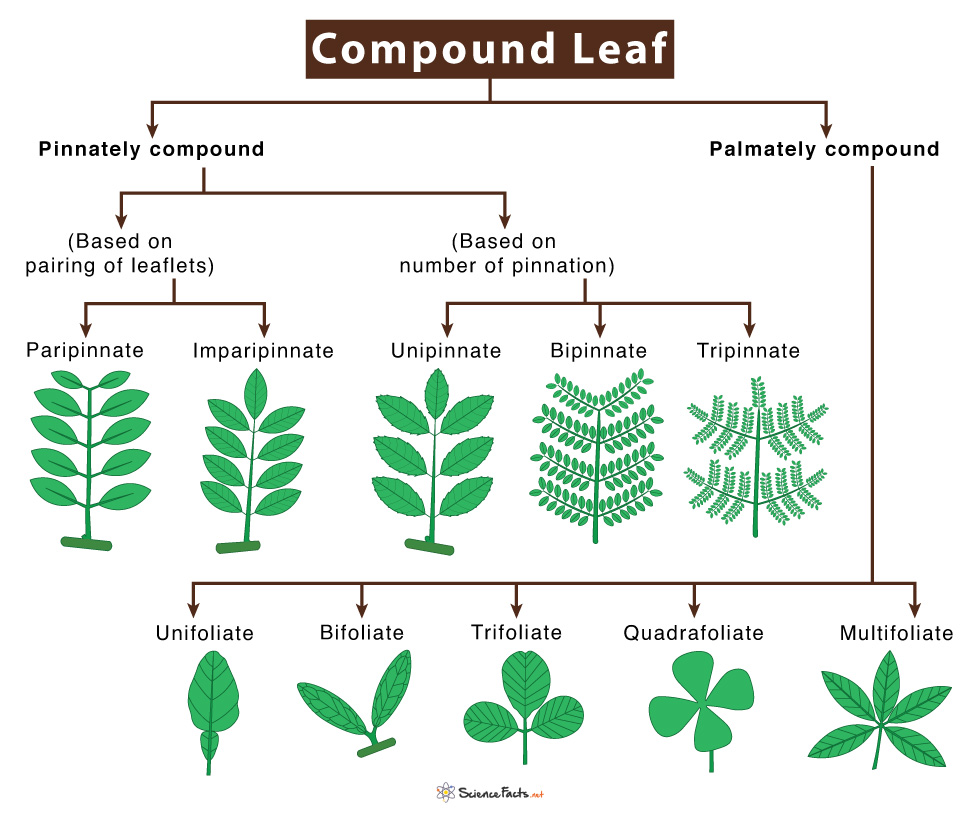What are the Two Basic Types of Leaves
Simple Leaf vs. Compound Leaf
Types of Leaves Based on their Shape
Types of Leaves Based on the Plants and Trees They are Found in
Examples: Maple, oaks, banana, guava, mango, black cherry, black gum and, sweat gum.
2. Compound Leaves
A leaf that is composed of multiple leaflets that are attached to the midvein, and having their own stalk. Examples: Neem, rose, clover, desert cotton, poison ivy, horse chestnut and, baobab. Based on the types of leaf veins and their arrangement in the lamina, compound leaves are further classified into two types: a) Pinnately Compound Leaf They are leaflets arranged symmetrically along the center of the leaf, where each leaflet appears to be attached or pinned to the midrib making the leaf look like a feather. Based on pairing of leaflets pinnately compound leaves are categorized into the following types:
Paripinnate (even-pinnate): Leaflets are borne in pairs along the rachis, ending with a pair of leaflets on either sideImparipinnate (odd-pinnate): Unlike paripinnate, here, a single leaflet is present at the anterior terminal end of the rachis
Examples: Pistachia lenticulus (paripinnate), Robinia (imparipinnate). Depending on the number of times the leaflet is attached to the midrib (pinnation), pinnately compound leaves are categorized into the following types:
unipinnate – single compound leaf attached to the midrib in an opposite fashionbipinnate – single leaflets of the unipinnate leaf gets replaced with unipinnate leavestripinnate – single leaflets of the unipinnate leaf gets replaced with bipinnate leaves
Examples: Azadirachta indica (unipinnate), Mimosa pudica (bipinnate) and, Moringa oleifera (tripinnate). b) Palmately Compound Leaf They are leaflets radiating outwards from the end of the petiole, similar to fingers of the palm of our hands. Based on the number of leaflets, the palmately compound leaf is categorized into the following types:
unifoliate – one leafletbifoliate – two leafletstrifoliate – three leafletsquadrifoliate – four leafletsmultifoliate – five or more leaflets
Examples: Citrus limon (unifoliate), Bauhinia yunnanensis (bifoliate), Acer cissifolium (trifoliate), Oxalis (quadrifoliate) and, Umbrella plant (multifoliate). 2) Leaves of conifer – Found in plants such as fir and pine 3) Leaves of angiosperm – Leaves of common flowering plants such as rose, dahlia and, sunflower 4) Sheath leaves – Elongated and tubular leaves as found in variety of grasses 5) Specialized and unusual leaves – Leaves of insect-eating plants such as pitcher plant and venus flytrap.



